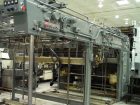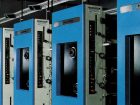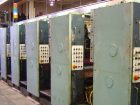
Features
Chronicle
Opinion
Birth and death of a press, how the Iron Curtain ushered in the half-size web
March 12, 2017 By Nick Howard
How the Iron Curtain ushered in the half-size web in the face of large-format offset to forever change print.
If you were born in the 1950s and chose printing as an occupation, then you already know most of this story. Pressrooms of larger commercial printers typically employed huge sheetfed machines – sheet sizes of 60- and 77-inch monsters. They were the epitome of highly successful businesses. The bigger the press, the more likely you were to be among the top 10 percent in the industry. Only heatset web offset plants were more substantial.
Such large format sheetfed printers existed because, as the amount of printing increased from the 1920s to 1970s, the only logical way to gain an advantage was to print more on a single sheet. Web offset was a much more segregated sector with different customers and very few web printers owned a sheetfed press.
Sixty-four-page signatures were common especially if you produced books and short-run magazines. Massive size sheets meant tremendous hurdles in handling and re-stacking or even turning over to print the back sides. Several machine makers developed blanket-to-blanket presses for one-over-one printing. George Mann and Crabtree cornered this market with presses in the 56- and 65-inch sheet size. The French company Marinoni made similar machines and was eventually bought by Harris.
None of these presses were easy to run. Older Manns required the plate clamps be removed and placed on a table whereby the plate was mounted. Then, along with the heavy clamps, hoisted back into the machine. But for one-colour book work like school books these presses saved a lot of time with a single pass through.
The binderies of the day faced just as many issues. Sheets – anywhere from 35 by 45 inches to 52 by 72 inches – would arrive and need to be folded. Dexter’s Quad folders were often used (all knife folds). If there were size changes it could take days to set up. Baum made monsters too, albeit not as large. These were all-buckle and, as with all folders of the time, had a very high feed table. I often joked that you needed oxygen to operate them. The biggest challenge was again in paper handling. Reams had to be hoisted by hand to load the feeders!
The industry of its day seemed content to follow the maxim of larger (sheet size) was better even though that meant everything else in a supporting role had to be huge. It seemed nothing else would give a printer a technical advantage over another. Web was an old-boys club few sheetfed printers would dare enter – even if they could scrape up enough cash to do so. In Canada, companies like Ronald’s, Maclean Hunter, Southams, Lawsons and Richardson Bond & Wright (RBW) held the keys to a door few would dare cross.
Quiet leap forward with GDR
If you visit Berlin take a stroll through the DDR Museum situated in the former East Berlin sector, just a short walk from the Brandenburg Gates. Inside you will see an interactive display of life in East Germany after the Second World War and up to 1989, when The Wall fell. Nearby a display of wooden hand grenades, which were given to children so they could practice chucking them over the wall when the decadent westerners invaded, there is a plaque that helps to define the miserable life that existed then. The East Germans provided the Eastern Bloc with the majority of hard currency by exporting the lion’s share of what they produced. Rejects were kept for the locals.
As the Iron Curtain fell upon Eastern Europe after WWII, many German businesses found themselves trapped in the wrong place and at the wrong time. One such firm, known today as ZIRKON, had a storied past going back to 1819. Originally known as J.F. Schelter & Giesecke they started out as type founders. By 1827 they started building printing machines. The now famous PHÖNIX art platen was well received all over Europe and sold well into the early 20th century. In 1952 Schelter & Giesecke, along with about 80 percent of the East German industry, found themselves reorganized into the new Volkseigner Betrieb (VEB) state-owned structures.
The company was renamed VEB Druckereimaschinenwerk-Universal Leipzig. Already having been involved with small reel-to-sheet machines before the war, they had designed and built a rather novel little web press known as the RZO. This was an offset press with three cylinders (plate, blanket and impression) and a sheeter, too.
Various stories exist on just how and why this VEB came up with such a concept. Rumours suggested because these machines were so small (they had a web width of 24 ½ inches and a cut-off off 17 3/8 inches) that the whole press could be loaded on a truck and driven all over the Eastern Bloc to print newspapers and propaganda. During 1952 they manufactured the RZO with only two units so only one-over-one printing was possible. By the next year, VEB expanded the line with the RZO II. It could run with four units and at speeds of only 8,000 iph. A folder was added that could be dollied into position in front of the sheeter. However, the small press had only two ink forme rollers, but this was fine for ground- wood newspaper stock and limited coverage only. Newspapers and flyers fit the bill.
By the time 1957 rolled around, a small New York company called Zarkin Machine Co. caught wind of the RZO. Zarkin, incorporated back in 1928, was into all sorts of things and not just printing. After the war they were building plate whirlers and graining machines and it is suggested that two of the owners, Charles Zarkin and Jerome Reinitz, had in 1949 financed the rebuilding of a bombed out printing press factory in Berlin. This may have been the firm KiekeBusch for shortly after a new company Royal Zenith appeared in the US and the Kiekebusch sheetfed was marketed under the name of the Royal Zenith Jobber. The KiekeBusch was an odd little press with a Spiess feeder and made entirely of either aluminum or the new Suluminum alloy created by the Nazis during the war. Zarkin and Royal Zenith were both connected to each other. One hundred and thirty five RZO II’s were bought by Royal Zenith and sold into the US market by 1957 and a new chapter of printing was about to be written.
In 1963, a revamped model of the RZO was designed. This press continued with the 3-cylinder principle but was faster and more refined. Called the Ultraset Junior RO62, it quickly found homes in both America and Canada. Marketed first as the Webmatic and then the Rubin 90, the press gained from Royal Zenith’s upgrades and demands to drastically change the printing landscape. A major incentive for anyone dealing with the East Germans was hard currency. The powerful US dollar was so desperately needed in the GDR that these machines were sold for ridiculously low money.
The mighty Harris Intertype Corporation was starting to take notice. Harris was the industry leader in sheetfed especially 60 and 78 presses. Back in 1953 Harris had already decided to enter the web business and purchased Dallas-based Cottrell Company. With Harris’s knowledge of offset and Cottrell’s letterpress web skills, it soon blossomed and a wide range of Harris-Cottrell web presses in all sorts of sizes from 16pp to 64pp took hold of the North American market. But Harris didn’t have a small half-size web and they could see clearly how Royal Zenith had created a brand new business of turning large format sheetfed printers into 8pp web shops. This was causing havoc with Harris sheetfed sales!
The argument was compelling for Royal Zenith. Paper would be cheaper, the press could eliminate folding in the bindery, fewer operators and most importantly faster speeds. No more monstrous platemakers or folding machines and paper cutters. No heavy handling of stock, perfecting was as simple as a turn-bar and machine footprint was not much more than a 38-inch sheetfed.
By 1963, Harris bought a successful forms press manufacturer by the name of Schriber. Out of this, on the commercial side, came the revamped M-90 long grain web press and shortly after a new short grain M-110. The big advantage of the M 110 was that it was a 4-cylinder blanket-to-blanket design – just like the bigger commercial presses. So now instead of turn bars, a 4-unit press prints four colours on both sides at the same time. Add a dryer and some chill rollers and Voila! – the perfect tool to decimate the large sheetfeds completely. This M 110 entry may have hastened Harris`s resolve to drop the complete sheetfed program in an extraordinary 1975 decision.
Not to be outdone, especially in a market they themselves had single handily created, VEB Polygraph/Royal Zenith had another press to launch in 1968. The ZIRKON 66 appeared (referred to in North America as the Royal Zenith 300) and it had all the same attributes as the Harris M 110 plus one very big advantage: Price! VEB Polygraph had come up with a press with some warts, but still able to produce high quality printing equal to sheetfed.
Over the next 15 years, Harris and VEB Polygraph/Royal Zenith would battle it out for market share while at the same time destroying forever the very large format sheetfed industry. By 1982, there were seven more competitors in this segment. Albert Frankenthal (now KBA) with its A 101, Miller Johannisberg with the CW68 and Webb 66 (a licenced copy of the Zirkon Forta 660), Komori with the System 20 (long grain), MAN with the Octoman, Heidelberg with the Web-8 (long grain), Hitachi 440 and 660, and Solna with its C-50. These were all similar 8pp presses and now marketed the same way. The age of the half-web was here to stay.
Both Harris and VEB Polygraph continually brought new technologies to the half web market. In 1978, VEB Polygraph launched the much improved FORTA 660 (or RZ420). The press ran 40,000 iph and was equally matched by Harris’s M 110 B.
Royal Zenith must have made a fortune on the VEB Polygraph association. They certainly did with its Planeta business as well as representing other Eastern Bloc combines like Brehmer, Perfecta and KOVO-Romayor. By the time of reunification (1990), Royal Zenith saw its advantage evaporate overnight and sold its interest to the newly formed and privatized Planeta. Planeta continued for a short time to represent the newly named VEB Polygraph (ZIRKON) but with virtually no cash and still bloated with too many employees, too much inventory and no cash, were gobbled up by KBA.
ZIRKON continues today in Leipzig as a privately held GmbH and has made forays into 16pp webs as it continues trading. The beginning of the end of the half-web happened slowly. And by 1995 drupa, new sheetfed technologies for perfecting 4 over 4 put a lid on its coffin. The advantage the half web once held over larger sheetfeds was eroded by the declining run lengths, lower waste (of new perfecting sheetfeds) and more efficient make-readies of 16pp page webs. The larger webs could, by the mid 1990s, easily compete with what had been an exclusive segment held by the little 8pp webs.
In the early days of half web, printers also started to realize that they could print new work like business forms, newsletters and direct mail, opening up more revenue streams for a press that was first idealized to print propaganda on bad paper.
Today manufacturers face a new challenge in keeping even the 40-inch press viable in the face of newer digital presses. This threat is real and the main impediments are the costs of such new (digital) technologies.
Currently there is severe sticker shock and something that is completely inverse to the story of the half web versus large sheetfed. Half webs can today be bought for less than the value of their metal. It is a reminder of how quickly printing technology changes today.
Print this page


